Key words:Ethnopharmacology, hallucinogenic plants, natural products, entheogen
Lozoya, X.; Navarro, V.; Arnason, J. T. and Kourany, E. (1989), Experimental evaluation ofMimosa tenuiflora(Willd.) Poir. (Tepeschohuite) I. screening of the antimicrobial properties of bark extracts.Archivos de Investigacin Medica,20,8793. [Links]
Tellez, P. J. and Dupoy de Guitard, J. (1990), Pharmaceutical preparation containing Mimosa tenuiflora extract with skinregenerating properties.Patent Eur Pat Appl.349, 469. [Links]
Jiang, Y. L.; Weniger, B.; HaagBerrurier, M.; Anton, R.; Beck, J. P. and Italiano, L. (1992), Effects of Saponins from Mimosa tenuiflora on Lymphoma Cells and Lymphocytes.Phytoter Res,6, 310313. [Links]
Callaway, J. C. (1988), A proposed mechanism for the visions of dream sleep.Medical Hypotheses,26, 119124. [Links]
Tellez and Dupoy de Guitard (1990) demonstrated the effectiveness ofM. tenuiflorain the topical treatment of the eczema (10% concentration), as well as against the inflammations (as a powder made from the dry bark) in the humans. In a similar experiment, the use of the dry bark ofM. tenuifloraproved to be effective in wound healing (Dupoy de Guitard, 1990) and in the treatment of venous leg ulceration disease (RiveraArce et al., 2007b).
Craig, C. R. and Stitzel, R. E. (1986), Farmacologia Moderna. Livraria Carioca, So Paulo. [Links]
Five 2phenoxychromones (uncommon flavonoids), the tenuiflorin A 5,7dihydroxy2(3hydroxy4methoxyphenoxy)6 methoxychromone, tenuiflorin B 5,7dihydroxy2(4hydroxy3methoxyphenoxy)6methoxychromone and tenuiflorin C 5,7dihydroxy2(3hydroxy4methoxyphenoxy)chromone, along with 6demethoxycapillarisin and 6demethoxy4Omethylcapillarisin were isolated from the leaves ofM. tenuiflora(Fig. 5). These uncommon flavonoids exhibited an unusual ether linkage between the B and C ring (Lon et al., 2004).
RiveraArce, E.; ChavezSoto, M.A.; HerreraArellano, A.; Arzate, S.; Aguero, J.; FeriaRomero, I.A.; CruzGuzman, A. and Lozoya, X. (2007b). Therapeutic effectiveness of aMimosa tenuifloracortex extract in venous leg ulceration treatment.J. Ethnopharmacol.,109, 523528. [Links]
These phenomena could be explained by the fact thatcarbolinas, which could be formed endogenously from the basic tryptamines such as 5hydroxytryptamine (serotonine) (Calaway, 1988; Calaway, 1994), were found inM. tenuiflora(MeckesLozoya et al., 1990a). The presence of these substances can result in MAO inhibition, which may lead to an increase in the amount of catecholamine in the central nervous system, provoking euphoric effects (Corbett, 1977). According to Ott (2002), there may be MAO inhibitors in the jurema preta extract, which would explain the observed effects. Nevertheless, the jurema wine is potentially visionaryper se. The inactivity of some preparations, might be due to insufficient dosage. Experimental studies are necessary to test this hypothesis.
Duke, J. A. (2000),Handobook of Medicinal Herbs, CRC Press, INC., Florida. [Links]
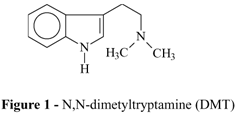
In the AfricanBrazilian cults,M. tenuiflorais also used to cure the infections and treat the inflammations (Albuquerque and Chiappeta, 1994). The wood is used in Honduras, Guatemala, El Salvador, Nicaragua, Colombia, and Venezuela to make a highly caloric charcoal (AndradeLima, 1954). In all of these countries, as well as in Panama, this species is used in the agroforestry management. In Mexico (especially in Oxaca and Chiapas) the wood is used for the charcoal, to construct the living (green) fences, and for the demarcation of the plots of the land, and animal pens (CamargoRicalde, 2000; RiveraArce et al., 2007a). The tannins extracted from this species are used in the paints and for tanning (CamargoRicalde, 2000). In Brazilian Northeast, it is said that the bark ofM. tenuifloracan cure the fatigue, or strengthen the uterus (Duke, 2000).
One of the species most important biological activities is related to its use in religious rituals. The hallucinogenic effect that accompanies the use of jurema is similar to that of LSD25, yet apparently of faster effect and shorter duration. Mydriasis and arterial hypertension are notably intense (Corbett, 1977). The psychic effects have been described by Matos (1983) as:(…) anxiety, dizziness, hollow head or airiness, waves of tickles passing through the muscles. Next, there is a state of daydreaming, with opaque vision and very strong colors and an apparent visual sharpening. Hallucinations follow, along with an accentuated visual background; perception becomes very distorted and there might be delirium.
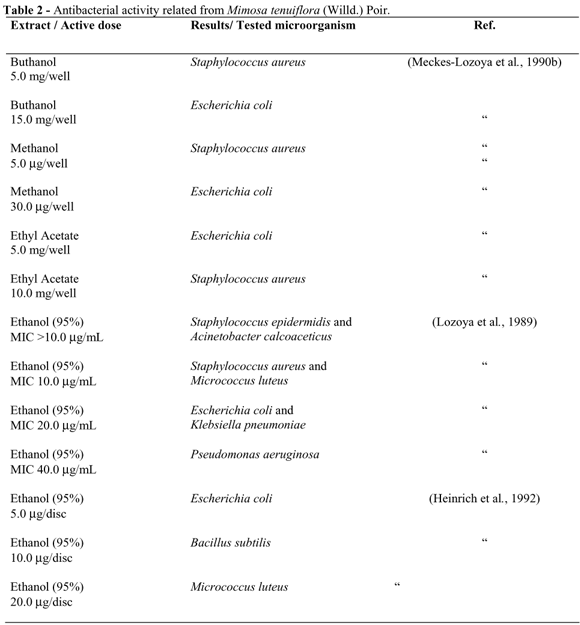
Corbett, C. E. (1977), Farmacodinmica.Editora Guanabara Koogan, Rio de Janeiro. [Links]
Anton, R.; Jiang, Y.; Weniger, B.; Becker, J. P. and Rivier, L. (1993), Pharmacognosy ofMimosa tenuiflora(Willd.) Poiret.J. Ethnopharmacol.,38, 153157. [Links]
Matos, F. J. A. (1983), Efeitos psicotrpicos de plantas brasileirasCincia e Cultura,35, 432434. [Links]
Banerji, R.; Prakash, D.; Misra, G. and Nigam, S. K. (1981), Cardiovascular and hemolytic activity of Saponins.Indians Drugs,52, 121124. [Links]
Although various aspects of the hallucinogenic effects of jurema have been shown, more studies would still be necessary to complete the knowledge of this plant. For example, there is no firm evidence yet that the drink is hallucinogenicper se, as suggested by Ott (2002), because its preparation is a consequence of the distinct cultural experiences. Perhaps an explanation can be found in the fact that the intensity of the effect seems to vary according to the different ingredients used by the different cultures. These different preparations represent not only regional influences, but also a wider interchange among the indigenous and AfricanBrazilian cultures. This interchange is clearly expressed in the preparation of the AfricanBrazilian beverage with the addition of alcohol and several other plant species (Albuquerque, 2001). As such, the different preparations may be responsible for the diverse manifestations recorded.
Heinrich, M.; Kuhnt, M.; Wright, C. W.; Rimpler, H.; Phillipson, J. D.; Schandelmaier, A.; and Wargurst, D. C. (1992), Parasitological and Microbiological Evaluation of Mixe Indian Medicinal Plants (Mexico).J Ethnopharmacol.,36, 8185. [Links]
MekcesLozoya et al.(1990b) reported thehemolytic activity of the raw extracts of the stem bark (Table 4). Triterpenic saponines, the substances considered responsible for this activity, cause membrane rupture in the erythrocytes (Banerji et al., 1981). Studies undertaken in 1992 detected a hemolytic effect in low concentrations of a methanol extract containing alkaloids, and a haemagglutinant effect in high doses (Heinrich et al., 1992).
Jiang, Y. L.; HaagBerrurier, M.; Anton, R.; Massiot, G.; Lavaud, C.; Teulon, J. M. and Guechot, C. (1991b), Structure of a new saponin from the bark ofMimosa tenuiflora.J. Nat. Prod.,54, 12471253. [Links]
Jiang, Y. L.; Massiot, G.; Lavaud, C.; Teulon, J. M.; Guechot, C.; HaagBerrurier, M. and Anton, R. (1991a), Triterpenoid glycosides from the bark of Mimosa tenuiflora.Phytochemistry,30, 23572360. [Links]
Willd. Poir.): a review of its traditional use, phytochemistry and pharmacology
Sangirardi Jr. (1989),O ndio e as Plantas Alucingenas. Editora Tecnoprint S.A., Rio de Janeiro. [Links]
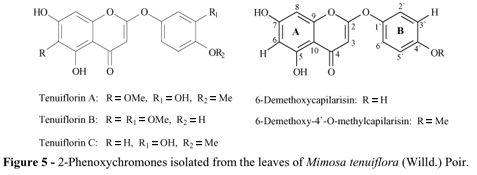
Batista, L. M. and Almeida, R. N. (1997), Central effects of the constituents ofMimosa opthalmocentraMart. ex Benth.Acta. Farm. Bonaerense,16, 8386. [Links]
RiveraArce, E.; Gattuso, M.; Alvarado, R.; Zarate, E.; Aguero, J.; Feria, I. and Lozoya, X. (2007a). Pharmacognostical studies of the plant drug Mimosae tenuiflorae cortex.J. Ethnopharmacol.,113, 400408. [Links]
Tables 2and3show results of the experiments undertaken to test for any antimicrobial activity of the substances from the bark ofM. tenuiflora. Tannins are probably responsible for most of this activity (MeckesLozoya et al., 1990b). An ethanol extract (95 %) was active againstMicrococcus luteusandBacillus subtilis(Heinrich et al., 1992).Table 3lists the species of the fungi (Microsporum canis,Microsporum gypseum,Trichophyton mentagrophytes,Trichophyton rubrum, andChaetomium indicum) against which the activity was observed. The substances extracted with ethanol (95%) were also effective againstCandida albicans(Lozoya et al., 1989).
Albuquerque, U. P. (1997), Etnobotnica de uma bebida cerimonial no Nordeste do Brasil.Rev Bras Farm.,78, 8689. [Links]
Ott, J. (2002), Pharmahuasca, anahuasca e juremapreta: farmacologia humana de DMT oral mais harmine. InO uso ritual da ayahuasca; Labate, B. C.; Arajo, W. S., eds., Mercado das Letras, So Paulo, pp. 661685. [Links]
The information presented here allow some conclusions with respect to the popular uses of jurema for the treatment of infections (Heinrich et al., 1992), treating minor burns, lesions, and eczemas (Tellez and Dupoy de Guitard, 1990), and for its antimicrobial activity (Lozoya et al., 1989; MeckesLozoya et al., 1990b). However, several other reported uses have not been examined: effectiveness against the hair loss, headaches, and toothaches; internal problems such as stomach acidity, gastritis, peptic and duodenal ulcers, colitis, and hemorrhoids; and herpes, acne, as well as parasiterelated diseases (CamargoRicalde, 2000).
Mota, C. N.; and Barros, J. F. P. (1990), Jurema: blackindigenous drama and representations. InEthnobiology: Implications and Applications. First International Congress of Ethnobiology; Posey, D. A.; Overall, W., eds., Museu Paraense Emlio Goeldi, Belm, pp. 171180. [Links]
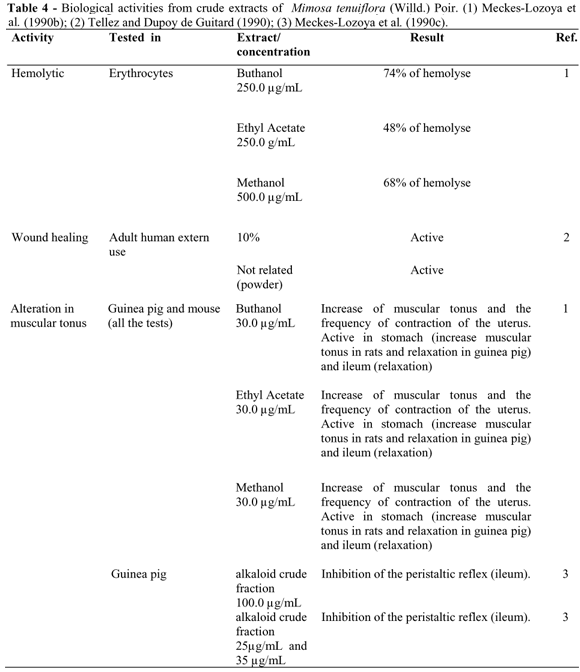
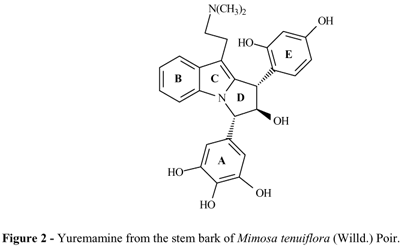
Sangirardi Jr. (1989) reported having takencauim(a preparation made with cachaa and jurema) several times, asserting that the jurema intensify the effect of the alcohol, giving a sensation of the happiness and peace, the sharpening of the vision and audition in the moments of relative silence, the latter effect being at times unpleasant. It caused drowsiness and heavy sleeping, resulting dreams and nightmares. This was followed by a strong hangover as well as slight tachycardia and considerable laziness. Albuquerque (1997), however, reported a euphoric state after the ingestion, as well as sweating (abundant at times), facial redness, and passing dizziness.
Rafael Sampaio Octaviano de SouzaI; Ulysses Paulino de AlbuquerqueI,*; Jlio Marcelino MonteiroI; Elba Lcia Cavalcanti de AmorimII
Mota, C.N. and Barros, J.F.P. (2002), O complexo da jurema: representaes e drama social negroindgena. InAs muitas faces da Jurema de espcie botnica divindade afroindgena.Mota, C. N. and Albuquerque, U. P., eds., Edies Bagao, Recife, pp. 1960. [Links]
The aim of this paper was to present a brief review of the phytochemistry, pharmacology, and traditional uses ofM. tenuiflora, as well as focus on its role in the cultural and religious manifestations among the indigenous groups in Brazil. The main source of information for this study was previously published literature onMimosa tenuiflora(Willd.) Poir. Data were also obtained from NAPRALERT (Natural Products Alert), a computerized database maintained by the University of Illinois in Chicago. This database contains information concerning the medicinal uses of many natural products, including their ethnomedical, pharmacological, and phytochemical profiles.
Historical and Ethnographic Aspects of the use of Jurema (Mimosa tenuifloraWilld. Poir.)
Albuquerque, U. P. and Chiappeta, A. A. (1994), O uso de plantas e a concepo de doena e cura nos cultos afrobrasileiros.Cincia and Trpico,22, 197209. [Links]
Fericgla, J. M. (1994a), Alucingenos ou adapatgenos inespecficos. InPlantas, Chamanismo y Estados de Consciencia, ed., Barcelona, La Libre de Marzo S.L., Barcelona, pp. 231252. [Links]
NAPRALERTSM(Natural Product Alert), Department of Medicinal Chemistry and Pharmacognosy, College of Pharmacy of the University of Illinois at Chicago. Funcional foods for health. Available in napra.html. [Links]
The pharmacological studies demonstrated that the hallucinogenic effect of N,Ndimetyltryptamine, when administered orally, was inhibited by the action of monoamino oxidases (MAO), insoluble enzymes found in the mitochondria (Corbett, 1977) that catalyzed the removal of an amino group alkaloid (Craig and Stitzel, 1986). For the hallucinatory effects to occur, it is also necessary to ingest the substances containing MAO inhibitors (such ascarbolines), which will then permit the action of N,Ndimetyltryptamine (Schultes and Hofmann, 1980).
Numerosas espcies de plantas so usadas para alterar estados de conscincia. Algumas so utilizadas para fins teraputicos, comoMimosa tenuiflora(Willd) Poir. (Mimosaceae) conhecida como juremapreta, uma planta alucingena, tradicionalmente utilizada pelos ndios no nordeste do Brasil. Nesta reviso, so considerados diversos aspectos do uso, fitoqumica e farmacologia desta planta.

The phytochemistry ofM. tenuiflorahas attracted considerable interest, mainly due to the presence of indole alkaloids and tannins (proanthocyanidins) (RiveraArce et al., 2007a). However, phytochemical reports on others classes of the compounds that may be present are rare.
MeckesLozoya, M.; Lozoya, X.; Gonzalez, J. (1990b), Propiedades farmacolgicas in vitro de algunos extractos de Mimosa tenuiflora (tepescohuite).Archivos de Investigacion Medica,21, 163169. [Links]
MeckesLozoya, M.; Lozoya, X.; Gonzalez, J. and Martinez, M. (1990c), Efecto producido por la fraccin de alcaloides de Mimosa tenuiflora (tepescohuite) sobre el reflejo peristltico del ilen del cobayo.Archivos de Investigacin Medica,21, 171174. [Links]
Camargo, M. T. L. A. (2002), Jurema (Mimosa hostilisBenth.) e sua relao com os transes nos sistemas de crenas afrobrasileiros. InAs muitas faces da Jurema de espcie botnica divindade afroindgena.Mota, C. N. and Albuquerque, U. P., eds., Edies Bagao, Recife, pp. 151170. [Links]
MeckesLozoya et al.(1990b), using a spray of the bark extract, observed (Table 4): the inhibition of the intestinal peristalsis due to a relaxation of the ileum smooth muscle tissue; an increase in the muscular tonus and in the frequency of the contractions of the uterus segments; and an increase in the muscular tonus of the stomach walls. All these experiments were performed with the rats and guinea pigs. The butanol extract was the most efficient, and contained the most alkaloids (MeckesLozoya et al., 1990b). A fraction containing the indolalkylamine and three other smaller bases were responsible for inhibiting the peristaltic reflex of the intestine, resulting in the relaxation of the ileum observed in the guinea pigs (MeckesLozoya et al., 1990c).
Schultes, R. E. and Hofmann, A. (1980), The botany and chemistry of hallucinogens.Charles Thomas Publishers, Springfield. [Links]
Pharmacological Studies on Pure Compounds Isolated fromMimosa tenuiflora(Willd.) Poir.
Pharmacological Studies of the Extracts
IIDepartamento de Cincias Farmacuticas; Centro de Cincias da Sade; Universidade Federal de Pernambuco; Av. Prof. Arthur de S, s/n; 50740521; Recife PE Brasil
Albuquerque, U. P. (2001),The use of medicinal plants by the cultural descendants of african people in Brazil.Acta Farm Bonaerense,20,139144. [Links]
Albuquerque, U. P. (2002), A jurema nas prticas dos descendentes culturais do africano no Brasil. InAs muitas faces da Jurema de espcie botnica divindade afroindgena. Mota, C. N. and Albuquerque, U. P., eds. Edies Bagao, Recife. [Links]
Among the several substances three steroids were isolated from the stem bark ofM. tenuiflora: campesterol3ObetaDglucopyranosyl, stigmasterol3ObetaDglucopyranosyl, and betasitosterol3ObetaDglucopyranosyl (Anton et al., 1993). Three saponins have also been identified: mimonoside A, mimonoside B, and mimonoside C (Fig. 4) (Anton et al., 1993; Jiang et al., 1991a; Jiang et al., 1992). Anton et al.(1993) recorded the presence of the triterpenoid lupeol.
Seigler, D. S. (2003), Phytochemistry ofAcaciasensu latoBiochem. Syst. Ecol.,31, 845873. [Links]
Most indigenous users shave the root or stem bark ofM. tenuiflorato prepare the drink (Lima, 1946; Sangirardi, 1989; Mota and Barros, 1990; 2002). Among the KaririXoko Indians, these bark shavings are extracted from the forest specimens (that should only be seen or touched by those initiated by the tribes older wisemen, under the restriction of the sexual taboo). The bark is then cooked in the water for a long period of time in a clay pot made especially for the occasion, until the drink acquires a thick consistency and a dark coloration (Mota and Barros, 2002). In practically all the indigenous rituals involving jurema, tobacco and candles are used. Today, these rituals are practiced in a festival called Tor, in which the Indians worship the religious entities, including the mythical ancestors, and sing the traditional songs (Grnewald, 2002).
Len, L.; Maldonado, E.; Cruz, A. and Ortega, A. (2004), Tenuiflorins AC: new 2phenoxychromones from the leaves ofMimosa tenuiflora(Willd.) Poir.Planta Med.,70, 536. [Links]
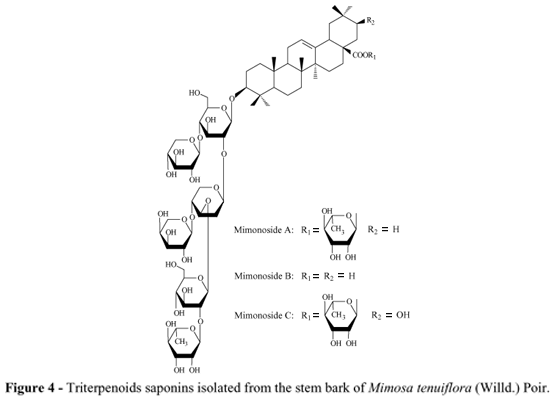
Fericgla, J. M. (1994b), Prefcio. In:Plantas, Chamanismo y Estados de Consciencia; Fericgla, J. M., (ed.). Barcelona, La Libre de Marzo S.L., Barcelona, pp. 715. [Links]
Schultes, R. E. (1994). El campo virgen en la investigacin de las plantas psicoativas. InPlantas, Chamanismo y Estados de Consciencia.Fericgla, J. M., ed., Barcelona, La Libre de Marzo S.L., Barcelona, 25116. [Links]
CamargoRicalde, S. L. (2000), Descripcin, distribucin, anatoma, composicin qumica y usos deMimosa tenuiflora(FabaceaeMimosoideae) en MxicoRevista Biologica Tropical,48, 939954. [Links]
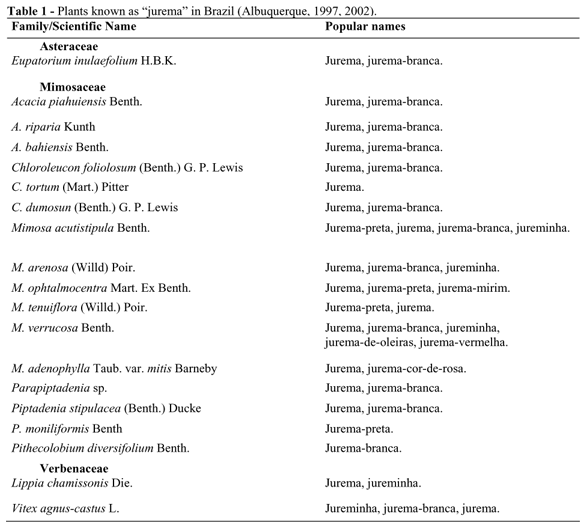
Other studies demonstrated the presence of two chalcones: kukulkan A (2,4dihydroxy3,4dimetoxychalcone); and kukulkan B (2,4,4trihydroxy3metoxychalcone)(CamargoRicalde, 2000) (Fig. 3).
Several terms have been used to describe the substances that provoke alterations in the human mind: psychotropic, hallucinogen, psychomimetic, schizogen, eidetic, psychotic, psychogen, and psychodisleptic are just some of them (Schultes, 1994). The most recent term is entheogen (God inside us) (Fericgla, 1994 a,b), coined in 1978 by a group of scientists led by Gordon Wasson (Mota and Barros, 2002).
Callaway, J. C. (1994),Carbolinas endgenas y otros alcaloides indlicos en los mamferos. InPlantas, Chamanismo y Estados de Consciencia; Fericgla, J. M., ed., Barcelona, La Libre de Marzo S.L., Barcelona, pp. 197230. [Links]
More studies are necessary to determine the activity of N,Ndimetyltryptamine in the human body, as well as its interactions with other substances. There are studies available on the interactions ofcarbolines with N,Ndimetyltryptamine. There is still a need for more indepth ethnopharmacological studies on the traditional preparation of jurema beverages, and more detailedin locoobservations.
We would like to thank Prof. J. M. BarbosaFilho (Laboratrio de Tecnologia Farmacutica, Universidade Federal da Paraba), for his support in the bibliographic survey using the NAPRALERT database. To CNPq for the financial support and grant given to U.P. Albuquerque.
Lima, O. G. (1946), Observaes sobre o Vinho da Jurema utilizado pelos ndios Pancar de Tacaratu (Pernambuco).Arquivos do Instituto de Pesquisas Agronmicas,4, 4586. [Links]
Grnewald, R. A. (2002), A jurema no Regime de ndio: o caso aticum. InAs muitas faces da Jurema de espcie botnica divindade afroindgena.Mota, C. N.; Albuquerque, U. P., eds., Edies Bagao, Recife, pp. 97124. [Links]
Numerous plant species are used throughout the world to achieve the modified states of conscientiousness. Some of them have been used for the therapeutic purposes, such as Mimosa tenuiflora (Willd) Poir. (family Mimosaceae) known as juremapreta, an hallucinogenic plant traditionally used for curing and divination by the Indians of northeastern Brazil. In this review, several aspects of the use, phytochemistry, and pharmacology of this plant are considered.
In northeastern Brazil, some indigenous tribes make use of jurema wine, or ajuc, as a miraculous drink. It is generally made from the plants of the Mimosaceae family, mainly juremapreta (For example:Mimosa tenuiflora(Willd) Poir.) (Albuquerque, 1997, 2001, 2002; Camargo, 2002). The substance responsible for its psychoactivity is a tryptaminic alkaloid called N,Ndimetyltryptamine (DMT) (Fig. 1). It is inactive when administered orally (MeckesLozoya et al., 1990a).
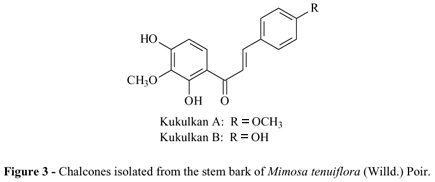
Very little information is available concerning jurema use among the Afrobrazilian cults, as its use is usually a wellkept secret. The preparation appears to consist basically of cooking the plants from different species, and then adding them to cachaa (a sugar cane distillate) or red wine. The product is kept in the dark receptacles, made of the clay or glass, for a variable number of the days (Albuquerque, 2002). Some of the plants added to the drink have confirmed the toxic effects. The final effect of the beverage can vary greatly among the preparations (Albuquerque, 1997). The AfricanBrazilian cults that use the plants with the common name jurema are distributed throughout several Brazilian states.
Alkaloids:Two indole alkaloids have been isolated from jurema: 5hydroxytryptamine, and N,Ndimetyltryptamine (MeckesLozoya et al., 1990a) (Fig. 1). The latter is also found in the root bark (Melo and Bandeira, 1961), and is linked to its hallucinogen use, as mentioned above. The alkaloid N,Ndimetyltryptamine was apparently detected for the first time by Gonalves de Lima and his team, after a visit to the Pancararu village in Brejo dos Padres (Pernambuco state, northeastern Brazil). The substance isolated was called nigerine (Lima, 1946). Ott (2002), however, suggested that this product could be an impure form of N,Ndimetyltryptamine. Vepslinen et al.(2005) performed one phytochemical study of this species with advanced instrumentation and methodologies, particularly1H13C nuclear magnetic resonance (NMR) and liquid chromatographymass spectrometry (LCMS) under mild acidic pH. A new phytoindole, Yuremamine, was isolated from the stem bark ofM. tenuiflorain this study (Fig. 2).
MeckesLozoya, M.; Lozoya, X.; Marles, R.; SoucyBreau, C. and Avalokitesvarasen, A. J.; (1990a), N,NDimethyltryptamine alkaloid in Mimosa tenuiflora bark (Tepescohuite).Archivos de Investigacin Medica,21, 175177. [Links]
IDepartamento de Biologia; Universidade Federal Rural de Pernambuco; Rua Dom Manoel de Medeiros, s/n;e.br; 52171900; Recife PE Brasil
Vepslinen, J. J.; Auriola, S.; Tukiainen, M.; Ropponen, N. and Callaway, J. C. (2005), Isolation and characterization of yuremamine, a new phytoindole.Planta Med.,71, 1053. [Links]
Herz, W. (2001), Chemistry of eupatoriinae.Biochem. Syst. Ecol.,29, 11151137. [Links]
All the contents of this journal, except where otherwise noted, is licensed under aCreative Commons Attribution License
Mimosa tenuiflora, as well as other species of theMimosagenus, have been used by the indigenous tribes in the cults in the northeastern Brazil since long before Portuguese colonization. After the colonization it was also utilized by the Afrobrazilians. The plant is used in making a hallucinogen drink that is called jurema wine by the indigenous groups such as the Truka (from the Assuno Island in Cabrob, Pernambuco state) and the Kambiwa (from Ibimirim, Inaj, and Floresta, Pernambuco state). Other groups call it jurema. The Pankararu (Brejo dos Padres Tacaratu, Jatob, and Petrolndia, Pernambuco state) identify the drink as ajuc; the Atikum (Serra do Um,sertoof Pernambuco) and the Kambiwa call it anjuc (Grnewald, 2002). There are at least nineteen different species known as jurema (seeTable 1). One element in common among these plants (or at least to their genera) is the presence of alkaloids (Herz, 2001; Seigler, 2003), active principles related to the ritual use of these plants by the indigenous people of the northeastern Brazil. In addition toM. tenuiflora, these compounds have also been isolated fromM. ophtalmocentra(Batista and Almeida, 1997). Some of the species cited inTable 1, however, principally those known as juremabranca (white jurema), do not contain tryptaminic alkaloids (Ott, 2002).
AndradeLima, D. (1954), Contribution to the study of flora of Pernambuco, Brasil.Monografia; Universidade Rural de Pernambuco, Brasil. [Links]
Melo, A. C. and Bandeira, J. A. (1961), . Contribuio ao estudo qumico e farmacolgico do alcalide da Jurema Preta (Mimosa hostilis Benth).Anais da Faculdade de Medicina da Universidade do Recife,21, 933. [Links]
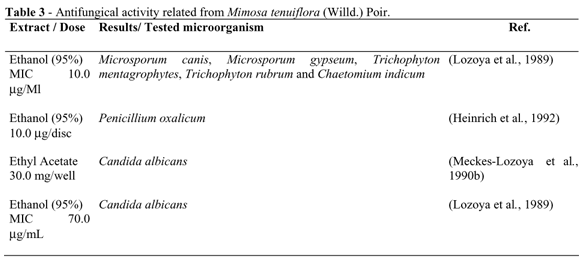
Secondary Metabolites ofMimosa tenuiflora(Willd.) Poir.